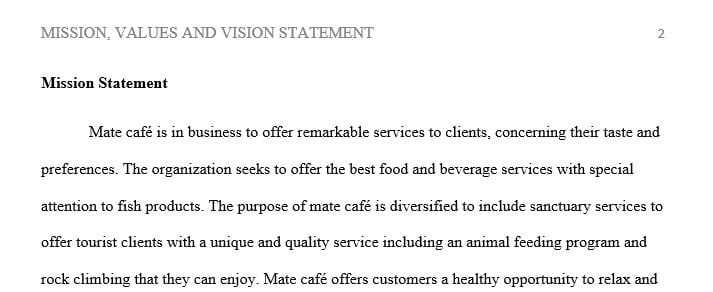Develop Mission, Values and Vision Statement
Developing a Mission Statement
1. Basically, the mission statement describes the overall purpose of the organization.
2. If the organization elects to develop a vision statement before developing the mission statement, ask “Why does the image, the vision exist — what is its purpose?” This purpose is often the same as the mission.
3. Developing a mission statement can be quick culture-specific, i.e., participants may use methods ranging from highly analytical and rational to highly creative and divergent, e.g., focused discussions, divergent experiences around daydreams, sharing stories, etc. Therefore, visit with the participants how they might like to arrive at description of their organizational mission.
4. When wording the mission statement, consider the organization’s products, services, markets, values, and concern for public image, and maybe priorities of activities for survival.
5. Consider any changes that may be needed in wording of the mission statement because of any new suggested strategies during a recent strategic planning process.
6. Ensure that wording of the mission is to the extent that management and employees can infer some order of priorities in how products and services are delivered.
7. When refining the mission, a useful exercise is to add or delete a word from the mission to realize the change in scope of the mission statement and assess how concise is its wording.
8. Does the mission statement include sufficient description that the statement clearly separates the mission of the organization from other organizations?
Developing a Vision Statement
1. The vision statement includes vivid description of the organization as it effectively carries out its operations.
2. Developing a vision statement can be quick culture-specific, i.e., participants may use methods ranging from highly analytical and rational to highly creative and divergent, e.g., focused discussions, divergent experiences around daydreams, sharing stories, etc. Therefore, visit with the participants how they might like to arrive at description of their organizational vision.
3. Developing the vision can be the most enjoyable part of planning, but the part where time easily gets away from you.
4. Note that originally, the vision was a compelling description of the state and function of the organization once it had implemented the strategic plan, i.e., a very attractive image toward which the organization was attracted and guided by the strategic plan. Recently, the vision has become more of a motivational tool, too often including highly idealistic phrasing and activities which the organization cannot realistically aspire.
1. Values represent the core priorities in the organization’s culture, including what drives members’ priorities and how they truly act in the organization, etc. Values are increasingly important in strategic planning. They often drive the intent and direction for “organic” planners.
2. Developing a values statement can be quick culture-specific, i.e., participants may use methods ranging from highly analytical and rational to highly creative and divergent, e.g., focused discussions, divergent experiences around daydreams, sharing stories, etc. Therefore, visit with the participants how they might like to arrive at description of their organizational values.
3. Establish four to six core values from which the organization would like to operate. Consider values of customers, shareholders, employees and the community.
4. Notice any differences between the organization’s preferred values and its true values (the values actually reflected by members’ behaviors in the organization). Record each preferred value on a flash card, then have each member “rank” the values with 1, 2, or 3 in terms of the priority needed by the organization with 3 indicating the value is very important to the organization and 1 is least important. Then go through the cards again to rank how people think the values are actually being enacted in the organization with 3 indicating the values are fully enacted and 1 indicating the value is hardly reflected at all. Then address discrepancies where a value is highly preferred (ranked with a 3), but hardly enacted (ranked with a 1).
5. Incorporate into the strategic plan, actions to align actual behavior with preferred behaviors.
Feasibility study for you to get an idea of what the business is about. It’s a Mate Cafe, it’s basically a coffee shop, but instead of coffee, Yerba Mate tea is served.
feasibility_study_mario_a_pinto_cortes
Solution preview for the order on develop Mission, Values and Vision Statement
APA
490 words
